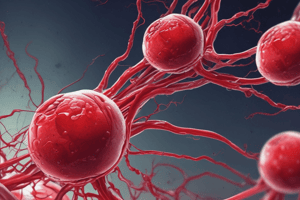Podcast
Questions and Answers
What crucial role do platelets play during the platelet phase of haemostasis?
What crucial role do platelets play during the platelet phase of haemostasis?
- They express adhesion molecules to attract endothelial cells.
- They form a fibrin mesh around the clot.
- They activate the extrinsic pathway of coagulation.
- They aggregate to form a platelet plug. (correct)
Which factor initiates the extrinsic pathway of coagulation?
Which factor initiates the extrinsic pathway of coagulation?
- Factor VIII
- Tissue factor (TF) (correct)
- Thrombin
- Prothrombin
What is the main outcome of the coagulation phase?
What is the main outcome of the coagulation phase?
- Formation of a platelet plug.
- Contraction of blood vessels.
- Activation of vasoconstrictors.
- Formation of a fibrin mesh. (correct)
In which phase of haemostasis is endothelial cell activation most critical?
In which phase of haemostasis is endothelial cell activation most critical?
Which laboratory test assesses the intrinsic and common coagulation pathways?
Which laboratory test assesses the intrinsic and common coagulation pathways?
What is the primary effect of anticoagulants in clinical treatment?
What is the primary effect of anticoagulants in clinical treatment?
Which disorder is characterized by a deficiency in specific clotting factors?
Which disorder is characterized by a deficiency in specific clotting factors?
What is the role of plasmin in the fibrinolysis phase?
What is the role of plasmin in the fibrinolysis phase?
Flashcards are hidden until you start studying
Study Notes
Overview of Haemostasis
- Definition: Haemostasis is the process by which bleeding is stopped, involving a complex interplay of vascular, platelet, and plasma factors.
Phases of Haemostasis
-
Vascular Phase:
- Immediate response to vessel injury.
- Vasoconstriction occurs to reduce blood flow.
- Endothelial cells become activated and express adhesion molecules.
-
Platelet Phase:
- Platelet adhesion: Platelets attach to the exposed collagen of the damaged vessel wall.
- Platelet activation: Activated platelets release granule contents (e.g., ADP, thromboxane A2) that recruit and activate more platelets.
- Platelet aggregation: Formation of a platelet plug through fibrinogen bridging between activated platelets.
-
Coagulation Phase:
- Series of enzymatic reactions forming a fibrin mesh.
- Involves clotting factors (I to XIII), divided into:
- Intrinsic pathway: Activated by trauma to the blood vessel.
- Extrinsic pathway: Initiated by tissue factor (TF) exposure to blood.
- Both pathways converge at Factor X, leading to the production of thrombin and subsequent fibrin formation.
-
Fibrinolysis:
- Process of breaking down the clot after healing.
- Plasminogen is converted to plasmin, which digests fibrin and dissolves the clot.
Key Components
- Platelets: Cell fragments crucial for plug formation.
- Clotting Factors: Proteins involved in clot formation (e.g., prothrombin, fibrinogen).
- Endothelial Cells: Line blood vessels and regulate coagulation.
- Vasoconstrictors: Substances that reduce blood vessel diameter (e.g., endothelin).
Disorders of Haemostasis
- Thrombosis: Abnormal clotting leading to blockage of blood vessels.
- Hemophilia: Genetic deficiency in specific clotting factors (e.g., Factor VIII, IX).
- Von Willebrand Disease: Deficiency or dysfunction of von Willebrand factor, affecting platelet function.
Laboratory Assessment
- PT (Prothrombin Time): Assesses extrinsic and common coagulation pathways.
- aPTT (Activated Partial Thromboplastin Time): Evaluates intrinsic and common pathways.
- Platelet Count: Determines the number of platelets available for haemostasis.
Clinical Implications
- Anticoagulants: Medications to prevent thrombosis (e.g., warfarin, heparin).
- Platelet Inhibitors: Drugs that reduce platelet aggregation (e.g., aspirin).
- Replacement Therapy: Treatment for bleeding disorders, such as factor concentrates for hemophilia.
Conclusion
Haemostasis is an essential physiological process involving multiple steps and factors, crucial for maintaining vascular integrity and preventing excessive bleeding. Understanding its mechanisms is vital for diagnosing and treating related disorders.
Haemostasis: The Process of Stopping Bleeding
- Definition: Haemostasis is a complex process involving blood vessels, platelets, and plasma factors to stop bleeding after injury.
- Three Phases:
Vascular Phase
- Immediate vasoconstriction to reduce blood flow.
- Endothelial cells activate and express adhesion molecules.
Platelet Phase
- Platelets adhere to exposed collagen in the damaged vessel wall.
- Activated platelets release factors (ADP, thromboxane A2), recruiting and activating more platelets.
- Platelet aggregation forms a platelet plug via fibrinogen bridges.
Coagulation Phase
- Enzymatic reactions create a fibrin mesh.
- Involves clotting factors (I to XIII).
- Two pathways:
Intrinsic Pathway
- Activated by vessel wall trauma.
Extrinsic Pathway
- Initiated by tissue factor released into blood.
- Both pathways converge at Factor X, leading to thrombin and subsequent fibrin formation.
Fibrinolysis
- Breakdown of the clot after healing.
- Plasminogen is converted to plasmin, which digests fibrin, dissolving the clot.
Key Components
- Platelets: Crucial for plug formation.
- Clotting Factors: Proteins involved in clot formation, including prothrombin and fibrinogen.
- Endothelial Cells: Line blood vessels and regulate coagulation.
- Vasoconstrictors: Substances like endothelin that reduce vessel diameter.
Haemostasis Disorders
- Thrombosis: Abnormal clotting leading to vessel blockage.
- Hemophilia: Genetic deficiency in clotting factors (e.g., Factor VIII, IX).
- Von Willebrand Disease: Deficiency or dysfunction of von Willebrand factor, affecting platelet function.
Laboratory Assessment
- PT (Prothrombin Time): Measures extrinsic and common coagulation pathways.
- aPTT (Activated Partial Thromboplastin Time): Evaluates intrinsic and common pathways.
- Platelet Count: Determines the number of platelets available for haemostasis.
Clinical Implications
- Anticoagulants: Medications (warfarin, heparin) preventing thrombosis.
- Platelet Inhibitors: Drugs (aspirin) reducing platelet aggregation.
- Replacement Therapy: Treatment for bleeding disorders, like factor concentrates for hemophilia.
Conclusion
- Haemostasis is crucial for maintaining vascular integrity and preventing excessive bleeding.
- Understanding its mechanisms is essential for diagnosing and treating related disorders.
Studying That Suits You
Use AI to generate personalized quizzes and flashcards to suit your learning preferences.





